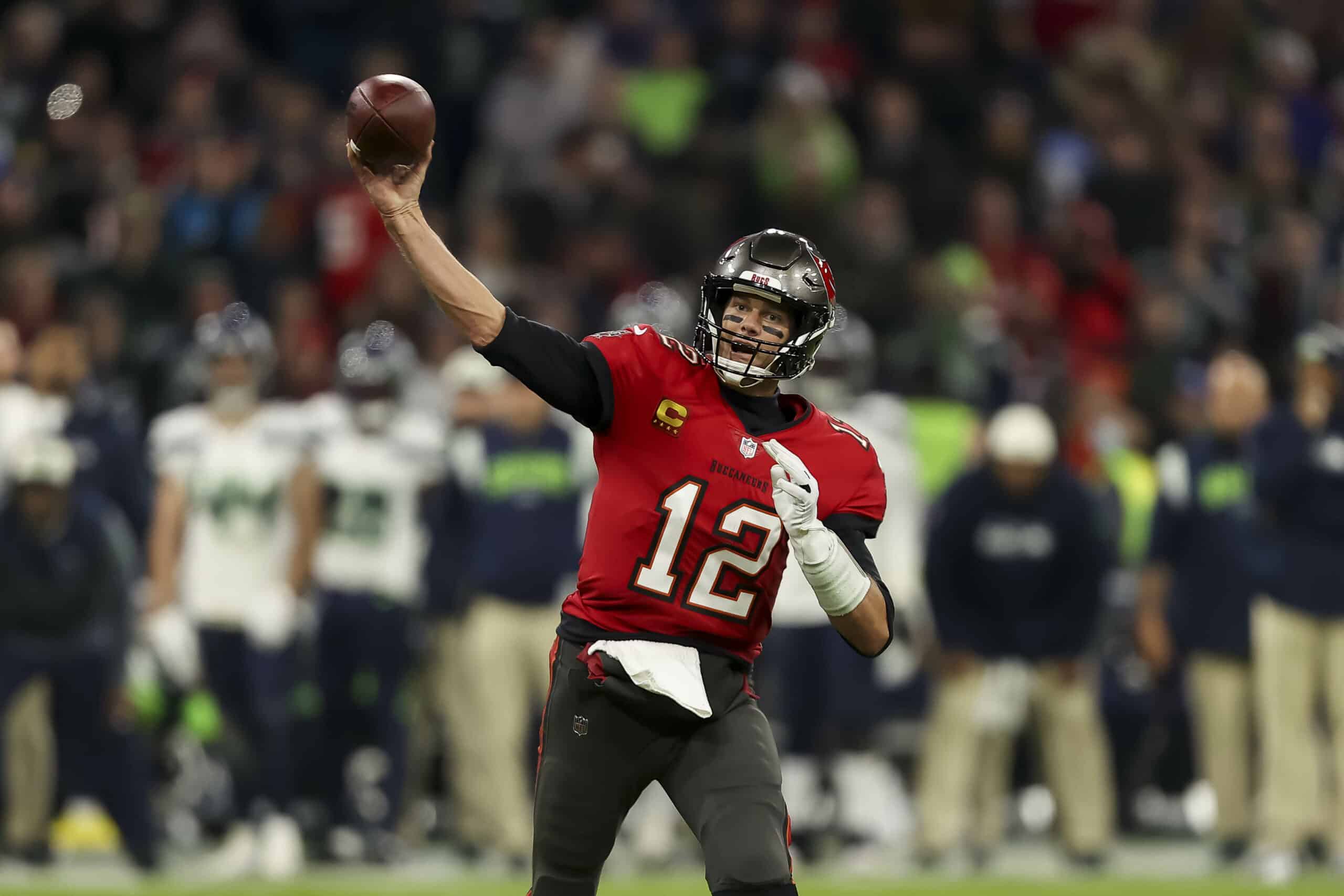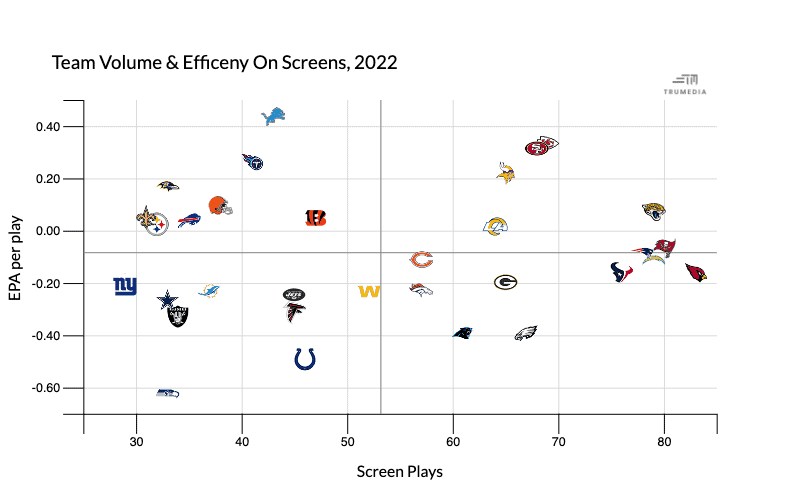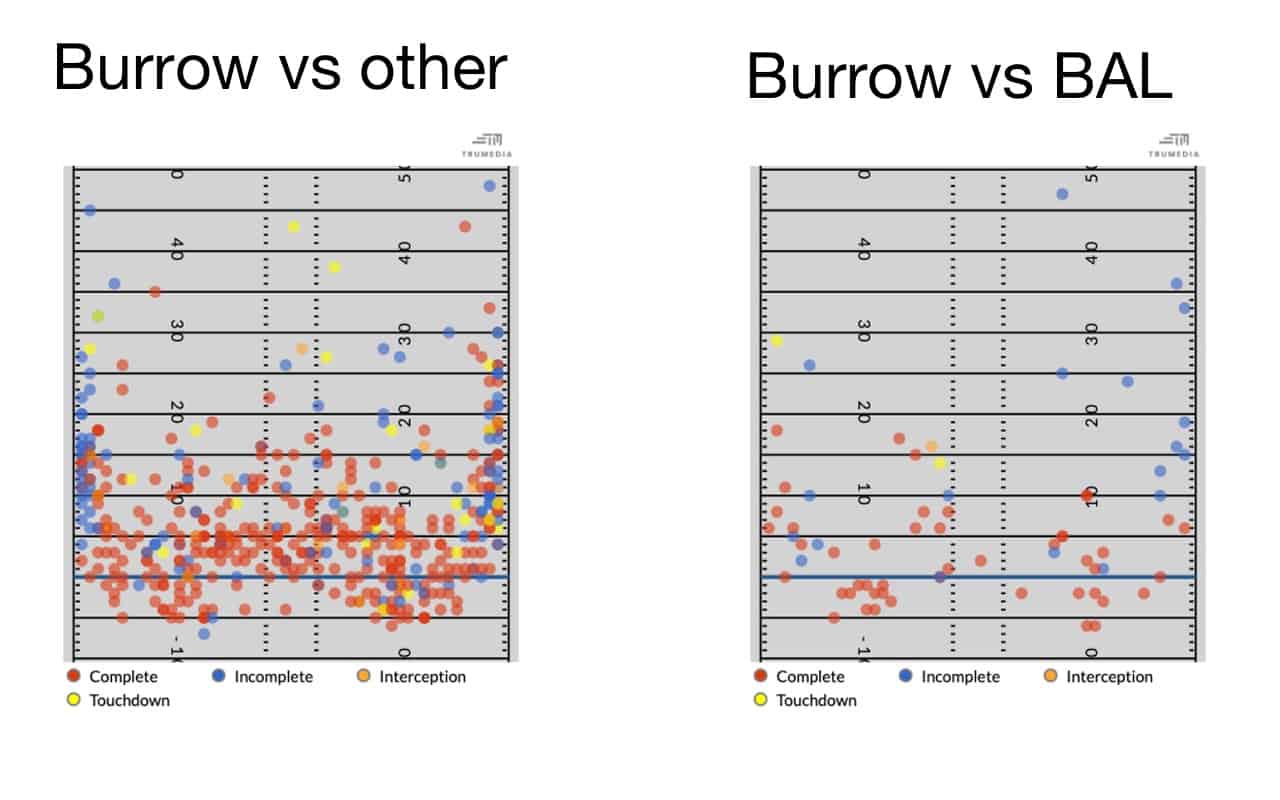Wild Card Weekend is upon us. We have six games over three days bringing a few exciting matchups, though we’ve seen them all before — each playoff matchup is a rematch from the regular season. That can give us a glimpse of what to expect in these games but there are still some lingering questions that could influence the results.
With that in mind, we’ve looked at one question for each of the six Wild Card matchups this weekend.
*data provided by TruMedia unless noted otherwise
Can Seattle create explosive plays?
When at its best, the Seahawks have been able to get the most out of shots down the field. This season, Geno Smith ranked fourth in EPA per play on throws of 11 or more air yards. He was second in total touchdowns on throws of that length (19) and first in touchdown rate (12.4%).
The 49ers can be beaten by a deeper pass. During the regular season, San Francisco ranked 19th in EPA per play on throws of 11 or more air yards. The problem for opposing offenses is that there haven’t been many opportunities to push the ball down the field with the 10th-fewest such passes against them this season.
That was the case with Smith and the Seahawks against the 49ers this season. Against any other opponent, Smith had an 8.0 average depth of target. In two games against the 49ers this season, Smith had an aDOT of 4.61. While the 49ers worked to deter those pass attempts, the Seahawks were accepting of trying to manufacture something short but that didn’t quite work out.
Smith had a 74.3% completion percentage against San Francisco, but with the low aDOT, he only averaged 5.88 yards per attempt.
Geno Smith by Opponent, 2022
data per TruMedia
| Opponent | EPA per play | aDOT | YPA | Comp% | EPA under Pressure | EPA when Clean |
|---|---|---|---|---|---|---|
| vs SF | -0.27 | 4.61 | 4.61 | 74.3% | -0.58 | -0.09 |
| vs non-SF | 0.06 | 8.00 | 7.72 | 69.1% | -0.28 | 0.20 |
So much of this comes down to San Francisco’s four-man rush. When the 49ers rushed four against the Seahaws, Smith’s aDOT dropped to just 2.95 yards. His average time to throw against a four-man rush was 2.52 seconds, which is one of his quickest of the season but not overly quick in a way of overemphasis on getting the ball out.
Seattle just doesn’t have a lot of ways to counter an aggressive four-man rush. The run game has been boom-or-bust throughout the season and those bust plays — 22.8% of attempts stopped at or behind the line of scrimmage was the fifth-highest rate in the league — just puts the Seahawks further behind the sticks in late downs. The Seattle screen game is also among the worst in the league.
The 49ers also mixed between playing off and press against the Seahawks receivers on the outside. The off coverage leaves some open space but only on the outside. Seattle refused to even test the middle of the field in the Week 15 matchup and the short throws to the outside were quickly stopped. Per Next Gen Stats, no 49ers defender allowed more than 27 yards in off coverage across the two games against Seattle this season.
Can Keenan Allen be enough for the Chargers?
In a Week 18 game that wasn’t going to change playoff seeding, the Chargers decided to play starters into the fourth quarter. In that game, Mike Williams was injured and after missing the week of practice he was rule out for the game and likely more with a fracture in his back.
The Chargers have been a completely different passing game with Williams and Keenan Allen on the field. On 177 dropbacks with both receivers on the field this season, Justin Herbert averaged 0.18 EPA per play with a 77.1% completion percentage and 7.93 yards per attempt. With just Allen on the field, which happened for 163 Herbert dropbacks, Herbert averaged -0.03 EPA per play with a 66.0% completion percentage and 6.59 yards per attempt.
But Allen can do damage in an area where the Jaguars have been susceptible throughout the season — in the slot. Jacksonville has struggled to find a capable slot corner. Darious Williams started the season there and struggled. Despite his 5-foot-9 frame, Williams plays bigger and better on the outside. Since he’s played more outside over the second half of the season, the Jacksonville passing defense has improved. Still, that leaves the Jaguars vulnerable in the slot. During the regular season, they ranked 29th in EPA per play on throws to the slot.
Allen lined up in the slot 60% of the time regardless of the other personnel on the field for the Chargers. Without Williams on the field, the Chargers have taken a few shot plays to Allen on the outside but most of his receiving work comes inside. When in the slot without Williams, Allen saw 27.7% of the team’s targets with 1.45 yards per route run.
Part of the problem with on/off splits is other circumstances that also play into the results. For example, center Corey Linsley also missed time throughout the season and these Allen/Williams splits are also with/without Linsely splits. Without Williams but with Linsley (on a smaller sample of plays), Allen has 1.70 yards per route run with a 32.4% target share from the slot. On those targets, Allen’s aDOT is just 4.55.
On short throws from the slot, the Jaguars ranked 32nd in EPA per play during the regular season with the same gap to No. 31 as between No. 31 and 22.
The Chargers’ dink-and-dunk offense can be frustrating but it might play a major part in making up for the loss of Williams outside.
Will the Dolphins establish the run?
With Skylar Thompson starting for the Miami Dolphins, there is not a lot of upside for the offense. One of the biggest effects of Tua Tagovailoa’s quick release was covering up a poor offensive line. Non-Tua quarterbacks have struggled to find a rhythm in the passing game as they’ve been pressured more often.
Dolphins Quarterbacks Pressure & Time To Throw, 2022
data per TruMedia
| Player | EPA/play | Pressure% | Time to throw | under 2.5 sec | 2.51 - 3.9 sec | 4+ sec |
|---|---|---|---|---|---|---|
| Tua Tagovailoa | 0.18 | 25.7% | 2.47 | 55.2% | 39.0% | 4.7% |
| Teddy Bridgewater | -0.06 | 45.3% | 2.96 | 39.5% | 45.3% | 15.1% |
| Skylar Thompson | -0.28 | 52.3% | 2.89 | 41.4% | 45% | 13.5% |
Add on the increase in press and man coverage for the receivers, the open windows created earlier in the season just aren’t there at the same rates.
The answer could come from the ground game, which was found some success late in the season as the Dolphins have had to adjust. Over the final four weeks of the season, the Dolphins were second in overall EPA on the ground and first in EPA per rush.
Despite heavier personnel that often used fullback Alec Ingold, the Dolphins saw the third-lowest rate of stacked boxes on rushing attempts in that span. However, Miami wasn’t creating a ton of free space with a below-average 1.48 yards before contact but with linebackers still having to come up to stop the run, the Dolphins were able to run through some of it with an average of 3.57 yards after contact, which was the second-highest rate in the league from Week 14 on.
The Buffalo defense can be hit or miss — or in this case hit and miss — in this category. Over the full season, the Bills ranked second in yards before contact (0.74) but also allowed the most average yards after contact per rush (3.58).
There’s no bigger swing here than against outside zone runs where the Bills averaged the lowest yards allowed before contact in the league — behind the line of scrimmage at -0.09 — but also allowed a league-worst 5.42 yards per rush after contact.
Raheem Mostert’s availability would be significant in this area. Mostert, who has been ruled out, averaged 0.05 EPA per rush on outside zone runs over the final four weeks of the season while Jeff Wilson averaged -0.26. While Miami succeeded running the ball overall in those final four weeks, that drop in production was just a blip for Wilson, who averaged 0.05 EPA per rush on outside zone runs over the course of the full season.
Can the Giants blitz effectively?
No defense wants to blitz more than the New York Giants. The Giants rushed five or more on 44.9% of plays during the regular season. No other team was over 40%. The No. 2 Arizona Cardinals were at 37.5%.
Blitzing wasn’t always effective for the Giants and that was the case in Week 16 against Kirk Cousins and the Minnesota Vikings. In that game, Cousins was blitzed on 51% of his dropbacks, and on those dropbacks he averaged 0.15 EPA per play, Overall on the season, Cousins was about average against the blitz, 0.02 EPA per play.
Cousins isn’t really the problem when blitzing the Vikings — it’s Justin Jefferson. Jefferson had a 30.4% target share when Cousins was blitzed this season and a league-leading 518 receiving yards. Only Amari Cooper (11) had more receptions of 20 or more yards against the blitz than Jefferson (10) this season.
In that Week 16 game against the Giants, Jefferson only had one reception of 20+ yards when the Giants sent extra men but overall had nine targets and 96 yards against the blitz.
Given how defensive coordinator Wink Martindale talked about the game this week, it doesn’t appear he’s going to take his foot off the gas in this rematch. While talking about the game, Martindale said great players make great plays. The question will be if the Giants have enough to try to slow that down.
When they blitzed against the Vikings in Week 16, they tried a few different things in coverage. The Giants played man coverage 30% of the time, most of which came in Cover-0. That aggressiveness worked. Cousins went 0-for-5 with one target to Jefferson and a sack against the Giants’ Cover-0 looks.
But when the Giants tried to give more help over the top of Jefferson, that’s when the damage occurred. The Giants had two blitz snaps in Cover-6 which resulted in a 13-yard pass to Jefferson and a Cousins sack. 30.8% of the Giants’ blitzes were backed by Quarters coverage. Against Quarters, Cousins went 3-of-5 targeting Jefferson with completions of 12, 10, and 17 yards.
Adoreè Jackson is expected to return for the Giants, which would be an upgrade over the cornerbacks the Giants ran out during the closing stretch of the season but Jackson hasn’t played since Week 11 and he ranks 60th among 64 qualified outside cornerbacks in adjusted yards allowed per coverage snap this season, using Sports Info Solutions charting.
Can the Baltimore defense keep the game close?
Lamar Jackson is out. Tyler Huntley was limited throughout the week but should be good to go. Even with the backup instead of third-string quarterback Anthony Brown, who started the Week 18 matchup against the Bengals, the Ravens’ offense takes a hit when the scheme over-reliant on a star quarterback is without the star.
If this game is going to be close, it’s going to come down to the play of the Baltimore defense. No unit has given Joe Burrow and the Cincinnati offense more fits this season. In his two games against the Ravens, Burrow has averaged -0.17 EPA per play. Against everyone else, he averaged 0.15 EPA per play.
The Ravens have taken the early blueprint against the Bengals — play two-high, take away the outside shots, and make Burrow checkdown — to the extreme. Against Cincinnati, Baltimore has its two highest rates of Quarters and Cover-6 along with their third-highest rate of Cover-2 in a game.
Ravens Coverages, 2022
data per TruMedia
| Opponent | Cover-1 | Cover-3 | Cover-2 | Cover-4 | Cover-6 |
|---|---|---|---|---|---|
| CIN | 5.7% | 26.0% | 13.8% | 22.8% | 20.3% |
| non-CIN | 14.5% | 38.3% | 10.2% | 12.0% | 10.2% |
Defenses have played this way against the Bengals for most of the season but the Ravens might be the most effective. Burrow has been forced to throw the ball short all season — his aDOT is 6.21 yards against the Ravens and 6.89 against everyone else — but Baltimore has been so good at limiting any big plays from happening regardless of the throw depth. Burrow has averaged 5.61 yards per attempt against the Ravens opposed to 7.64 against everyone else.
The Bengals’ attempt to counter the two-high is by getting the ball out quickly. He’s averaged 2.39 seconds to throw with 63.8% of his throws within 2.5 seconds of the snap. That’s also featured over a third of his passes (33.8%) at or behind the line of scrimmage. Baltimore has been able to rally and tackle, leaving no room for those plays to develop or break free.
The Bengals averaged an opponent-low 8.82 yards per reception against the Ravens. Just 29.7% of targets resulted in a first down against Baltimore while 38.3% of Bengals targets against everyone else did. Overall, the Bengals were ninth in targets per first down for the season.
Holding onto the ball and waiting for plays to open up down the field could also be dangerous without Alex Cappa and La’el Collins on the offensive line. On plays against the Ravens when Burrow held onto the ball for 2.5 seconds or more, he averaged -0.46 EPA per play and was pressured on 46.7% of his dropbacks.
Will the Buccaneers hurry up?
The Tampa Bay Buccaneers have two distinct offenses — the only they try to run for the first three quarters of the game and the Tom Brady-controlled hurry up in the fourth quarter when the Buccaneers are trailing and have to score quickly.
On no huddle plays, the Buccaneers are tied for the league lead with 0.26 EPA per play. Most of that volume comes in the fourth quarter when the Bucs have used it out of necessity. But that efficiency stays exactly the same when we look at no huddle plays through the first three quarters of a game. In those situations, Tampa Bay ranks fourth in EPA per play.
On non-no huddle plays in the first three quarters, the Buccaneers rank 28th in EPA per play, better than only the Cardinals, Texans, Jets, and Colts.
Brady also looks more comfortable in the no huddle offense. He’s pushing the ball down the field more while making fewer mistakes.
Tom Brady No Huddle Splits, 2022
data per TruMedia
| No Huddle | Dropbacks | EPA/Play | aDOT | YPA | Comp% | INT% | Deep% |
|---|---|---|---|---|---|---|---|
| Yes | 174 | 0.28 | 8.00 | 7.79 | 70.3% | 0.6% | 14.0% |
| No | 502 | -0.03 | 6.45 | 5.98 | 65.8% | 1.4% | 9.3% |
This isn’t a “build the whole plane out of hurry up” because that won’t be sustainable over the whole game. But there are pieces that work from what the offense looks like in those situations but the Bucs don’t appear to have the self-awareness to sprinkle them into the full offense. Tampa Bay is one of two teams with zero no huddle plays in the first quarter of a game this season.
When using no huddle through the first three quarters, the Buccaneers have the third-fastest seconds per play. Given that the Buccaneers haven’t fully embraced motion or play-action this season, the no huddle element could be used as a factor to keep the defense off-guard — especially against a pass rush like the Cowboys, a team with the sixth-fastest get-off in the league, per Next Gen Stats. The Buccaneers could also keep defensive personnel on the field while they get to the line quickly. All of those things are to Brady’s advantage.
The Buccaneers were still the fastest offense in the league in overall seconds per play (and first on non-no huddle plays) so speed is still an element they’ve tried to use throughout the season. Yet, there’s been a disconnect in the ways they could use it better.
Throughout the season there has been a lack of self-awareness from the Tampa Bay offense identifying what it does and does not do well, but leaning into more no huddle and what those plays represent could be the fastest way to an offensive turnaround.


















